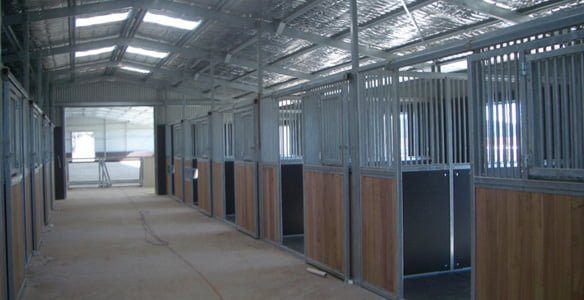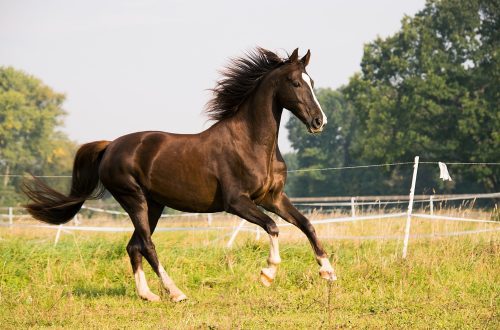
How to protect your stable from fires
How to protect your stable from fires
A stable fire is the horse owner’s worst nightmare imaginable. Neither new stables nor old ones are immune from fire. Experts say you only have eight minutes to get the horses out of the fire. If they stay in a smoky room for longer, inhaling the smoke can lead to irreversible health effects …
Therefore, it is precisely the concern for the prevention of fires, compliance with fire safety rules that should become one of the main tasks of stable owners. It is necessary not only to draw up and work out a plan of necessary actions in case of a fire, but, first of all, to assess the stable for existing fire risks, eliminate all shortcomings and prevent their occurrence in the future.
For advice and guidance, we turned to experts. All of them are experienced horse owners. Tim Collins of California is a Rescue Technical Specialist for the Santa Barbara Humane Society and Advisor to the Santa Barbara Equestrian Center. Among other things, he analyzes the behavior of horses in anticipation of fires, floods and earthquakes. Ken Glattar of Lake Tahoe Security Services, Inc. in Reno, Nevada, is a fire researcher. Doctor Jim Hamilton pIn addition to his regular veterinary practice with Southern Pines Equine Associates North Carolina, he is a member of the Moore County Emergency Response Team. And Lieutenant Chuck Younger of the Southern Pines Fire and Rescue Department not only teaches fire safety to horsemen, he also instructs firefighters on how to handle horses in emergencies. All of our experts conduct seminars and trainings on fire safety and fire incidents in horse holding areas.
preventive measures
First of all, you need to pay attention to the “weak” places, holes in the fire safety system, eliminate the risks.
Store feed separately. This point is emphasized by all experts! Hay inside bales or bales may, which is fraught with spontaneous combustion due to the occurrence of a thermal reaction. Therefore, it should be stored only (!) in a hay storage, and not next to the stalls.
Take precautions. Keep in the stable the minimum amount necessary to ensure an uninterrupted supply of horses.
“Five to ten bales, preferably at ground level, away from electrical wires and lights,” Chuck advises. His brother’s stable burned down because a hay supplier carelessly tossed bales up to the ceiling, where the hay made contact with a bare wire.
“Leave a gap between the bales,” adds Tim. “This will help dissipate the moisture that leads to strife. Install a smoke detector and a heat detector above the hay on the ceiling.”
Check your hay often. About a month after the hay has been delivered to you, open the bales or bales and lift it up if it is not baled. If the hay is warm inside, spontaneous combustion is possible. Take the bales warm inside out into the street, throw away the rotten ones, lay them out and dry if you haven’t had time to ban them.
«Do not smoke!” – should be the main rule in the stable. Install appropriate decals. Don’t make an exception for anyone!
“I often watch how farriers smoke between forgings right in the stable,” says Chuck. “One stupid mistake and you lose everything!”
Protect and insulate the wiring. Rodents love to gnaw on wires – take care of safety and pack all wiring in metal conduit. Secure the structures so that the horse, while playing, could not damage them. If you notice that the horse likes to play with pipes that have electricity, distract him by giving him other toys. Regularly check the integrity of the pipeline, especially at bends.
Protect lamps. Enclose each lamp with a metal or plastic cage that the horse cannot rip or damage.
Beat the stalls correctly. Try to keep the bedding from becoming compacted – let the groom loosen it. Through loose bedding, fire will not spread as quickly as it could.
Remove flammable items from the stable. Check every jar and bottle. If it says “flammable” on it, do not store it in the stable in the public domain. Get a box made of refractory material to store such items. For the same reasons, do not leave a lawn mower or brushcutter in the stable. Remove paint cans, especially once opened ones, as flammable fumes can accumulate in them.
Keep order. Debris that accumulates in the stable can help spread the fire. Get out on time, do not store junk. Free the stable passage from foreign objects.
Sweep the aisles. Sweep the passage and remove regularly the remains of hay, sawdust, manure. Remove cobwebs – they are highly flammable. Get rid of dust, especially dust that builds up in heaters, on heat lamps, and around your water heater. Remove dust from smoke detectors as well – it can cause false alarms.
Be careful with extension cords. “We would rather not see them in the stables,” says Chuck, “but they are needed, at least for using a trimmer machine.” Use strong wires with good insulation. When you finish work, do not throw away the extension cord, unplug it and put it in a drawer.
Do not place extension cords near hay – dust or hay particles can get into the outlet. If contact occurs, the particle will smolder for a long time, which may result in a sudden fire. “People think that the wiring ignites on its own. It happens, but more often the fire occurs because of such a dust particle that has flown into the outlet, ”Ken warns.
If you are just starting to build a stable, then it is better to install a sufficient number of sockets with plugs so that later you do not need to use extension cords. The cost of sockets is relatively low, and the level of fire safety increases significantly! This opinion is shared by all our experts.
Heating elements. Your mini tractor, clipper, heater, anything with an engine or heating element should be kept away from hay, sawdust, and flammable objects.
Make sure the engine or heater is cool before you leave it unattended.
Vegetation around the stables. Remove fallen leaves, keep weeds from growing. Vegetable “garbage” contributes to the spread of fire.
Keep the dungeon away from the stable. Manure, which you store before special services take it out or you do it yourself, also begins to gradually smolder from the inside. It is very flammable!
Now that you’ve secured your stable, invite an expert if possible, who can evaluate your work and suggest what else can be done to avoid a fire.
Protection The following tips will help you improve your fire safety. Some of them are easy to perform, some require a more serious approach.
Address. Know the exact address of your stable. The fire department may not be able to locate you by name or approximate description.
Provide normal conditions for the entrance of cars to the entrances of the stable. Both the road and the gate, and the required amount of free space matter. The fire department will not be able to help you if the car does not have the opportunity to drive up to the stable.
Access to water. If there is not much water near your stable or it is not connected, always keep a spare water tank.
Chuck’s rule is 50 liters of water for every bale of hay (if a fire breaks out in a hay store where you have 100 bales of hay, firefighters will need about 5 tons of water to put out just the hay)! The amount of water that the fire brigade will bring with them will not be enough to extinguish this amount of hay. Make sure that you can get more water at any time.
Halters and cords. Each stall should have a lead and halter hanging so that you do not have to waste time looking for them if you need to take the horses out of the stable. There should be some material (fabric) at hand with which you can cover the horse’s head, tie his ears and eyes. This cloth does not need to be kept by the stall (where it will collect dust), but you should know where it is.
“Take care of yourself too. Come to the horse in long sleeves. A frightened horse act aggressively and bite your arm,” Tim warns.
Horses have a developed instinct to run into the stall from danger, even if the stable is on fire. To dampen this instinct, Chuck often moves the horses from stall to stall towards the exit.
Identify and mark all exits.
Install fire extinguishers. Chuck recommends keeping an ABC (chemical) fire extinguisher in the stables in the break room. If the bedding catches fire, you will need water. A chemical fire extinguisher will help put out the flames, but the bedding will smolder. If an electrical fire occurs, use only a chemical fire extinguisher.
Availability of hoses of the required length. Make sure that the hose connected to the water supply reaches every corner of the stable. If you ever have to put out a fire yourself, make sure there is no smoldering bedding left anywhere.
Install smoke detectors. Keep them clean and change the batteries in time.
Keep a flashlight near any front door and regularly check the batteries in it.
Emergency phone numbers. These telephone numbers must be written on plates and placed in places accessible for viewing. Also, the signs should indicate the address of your stable, perhaps landmarks and more convenient ways to get there. You can even write a verbal description card for yourself and ask someone from the outside to come to your stable on it. Let him say his opinion, is it easy to navigate through it. Correct it and also write on the tablet. Specify the coordinates of the navigator (if possible)
Contact the emergency services in your area in advance. Leave the dispatcher your coordinates. Let them already be in the database.
Build a levada in case of fires – you can put horses taken out of the fire into it. It should be on the leeward side so that the horses do not inhale the smoke. Make sure her gate opens easily with one hand. Install a spring block that closes the gate automatically so you can quickly rush after the next horse.
Make a fire action plan and practice it with horses, stable staff, private owners and frequent visitors.
duplication of information. Do not keep the originals of any important documents in the stable. If you need them to be on display and in the public domain, make copies. Keep originals only at home.
Make a list of essential medications and constantly check it for the presence of drugs in your first aid kit.
Check the stable in the evening every day. Check first the condition of the horses, and then the order in the stable. Pay attention to those rooms where there may be a TV, kettle, stove, trimmer, etc. plugged into the outlet. Make sure that all wires are removed from the aisle, all electrical appliances and lights are turned off. Maintain order.
Make a plan of what you should check periodically. For example, fire extinguishers this month, general cleaning next month, etc. So you can organize the work in your stable. Organization and control is 50% security.
Deborah Lyons; translation by Valeria Smirnova (source)





